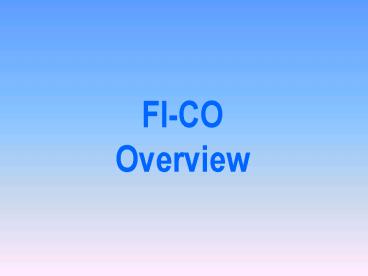FICO - PowerPoint PPT Presentation
1 / 21
Title:
FICO
Description:
FI-SL. FI-LC. General Ledger. Accounts Receivable. Accounts Payable. Asset Accounting ... Offers special functions for leased assets and assets under construction. ... – PowerPoint PPT presentation
Number of Views:1987
Avg rating:3.0/5.0
Title: FICO
1
FI-CO Overview
2
FI - CO Overview
Organization Structure and Organization Units.
Functional Components in FI and CO. Overview
of individual components
3
Organizational structures in the SAP System
CLIENT
CHART OF ACCTS
CHART OF ACCTS
COMPANY CODE
COMPANY CODE
COMPANY CODE
BUSINESS AREA
BUSINESS AREA
BUSINESS AREA
BUSINESS AREA
4
Organizational Units in the SAP System
Client
Companycode
Businessarea
Credit Controlarea
Application-spanning unit
independently balancing unit
Unit for which internal balance sheets can be
created
Organization unit that specifies and checks
credit limits for customers
5
Organizational Units in the SAP System
Client
ControllingArea
OperatingConcern
Profit Center
Application-spanning unit
Organization unit for cost accounting
Organization unit for profitability analysis.
Organization unit for profit center accounting
6
The Functional Components of FI
FI-GL
FI-SL
Special Purpose Ledger
General Ledger
FI-AR
FI-LC
Accounts Receivable
Legal Consolidation
FI-AP
Accounts Payable
FI-AA
Asset Accounting
7
The Functional Components of CO
CO-CCA
EC-PCA
Profit Center Accounting
Cost Center Acctg
CO-IO
CO-PA
Internal Orders
Profitability Analysis
CO-AC
Activity-based Costing
CO-PC
Product Costing
8
General Ledger Overview
- Complete record of all business transactions.
- Centralized up-to-date reference for actual
individual transactions at various levels. - Automatic and simultaneous posting of all
sub-ledger items. - Simultaneous updating of general ledger and cost
accounting areas. - Real-time evaluation and reporting on current
accounting data.
9
Accounts Receivable Overview
- Complete record and administration of all
customer business transactions. - Integral part of sales and credit management.
- Provides data for optimization of liquidity
planning. - Range of tools to monitor open items flexible
dunning, analyses, alarm reports and due date
lists.
10
Accounts Payable Overview
- Complete record and administration of all vendor
business transactions. - Integral part of purchasing and invoice
verification application. - Provides data for optimization of liquidity
planning. - Powerful automatic program for settling payables
Different payment methods as well as those
specific to different countries.
11
Asset Accounting Overview
- Complete record and administration of all fixed
assets. - Encompasses the entire lifetime of assets from
acquisition to retirement. - Provides data and forecasts for depreciation,
interest, insurance. - Offers special functions for leased assets and
assets under construction. - Powerfully integrated with other R/3 systems such
as MM, PM and CO.
12
Special Purpose Ledger
- Ledgers are for reporting purposes. This allows
you to report at various levels using the values
from the various application components. - It allows us to collect information, combine
information and create totals.
13
Legal Consolidation Overview
- Creation of financial statements for a corporate
group in accordance with the entity theory to
meet legal requirements for external financial
reporting purposes as well as internal
informational requirements.
14
Link between FI and CO
General Ledger Account and Cost Element
Client 006
Chart of accounts
Chart of accounts
G/L acct. 400000
Cost elem. 400000
Controlling area 1000
Company code 1000
G/L acct. 400000
Cost elem. 400000
FI
CO
15
Cost Center Accounting Overview
- Determines where costs occur in the organization.
- Enables cost controlling by assignment and
posting of costs to organizational sub-areas
where they may be influenced the most.
16
Internal Orders
- Internal orders are normally used to plan,
collect, and settle the costs of internal jobs
and tasks. - An internal order is used to monitor parts of the
costs, and under certain circumstances, the
revenues of the organization.
17
Activity-based Costing Overview
- The primary goal is not simply to lower costs in
individual departments but to optimize entire
process chains. - Other goals of Activity-Based Costing include
shortening lead times and improving quality. - By integrating Activity-Based Costing into
profitability analysis, you can create more
realistic views of your revenue position.
18
Product Costing Overview
- Calculation of the cost of goods manufactured
(COGM) and the cost of goods sold (COGS) of a
product. - can use the Product Cost Planning functions to
calculate the cost of goods manufactured (COGM)
and cost of goods sold (COGS) for products such
as materials and services. The costs may then be
analyzed and used in business decisions (such as
whether to make or buy). - Establish how the costs are broken down for each
product, and to calculate the value added for
each step of the production process
19
Profit Center Accounting Overview
- The main aim of Profit Center Accounting is to
determine profit for internal areas of
responsibility - By assigning balance sheet items (asset
portfolio, payables and receivables, material
stocks, work in process) to profit centers, you
can analyze your fixed assets by profit center,
thus using them as investment centers. - This makes it possible to expand profit centers
to investment centers. This also makes it
possible for you to analyze a number of key
figures by profit center, including return on
investment, working capital and cash flow
20
Profitability Analysis Overview
- An object within Profitability Analysis to which
costs and revenues are assigned. - A profitability segment corresponds to a market
segment. You can calculate the profitability of a
profitability segment by comparing its sales
revenues against its costs. - Can be implemented in any branch of industry with
any form of production.
21
Thank You































